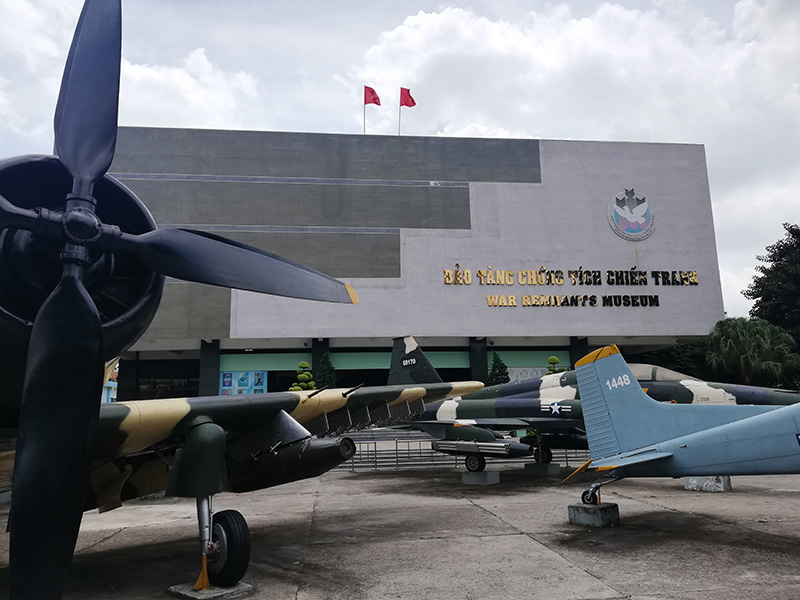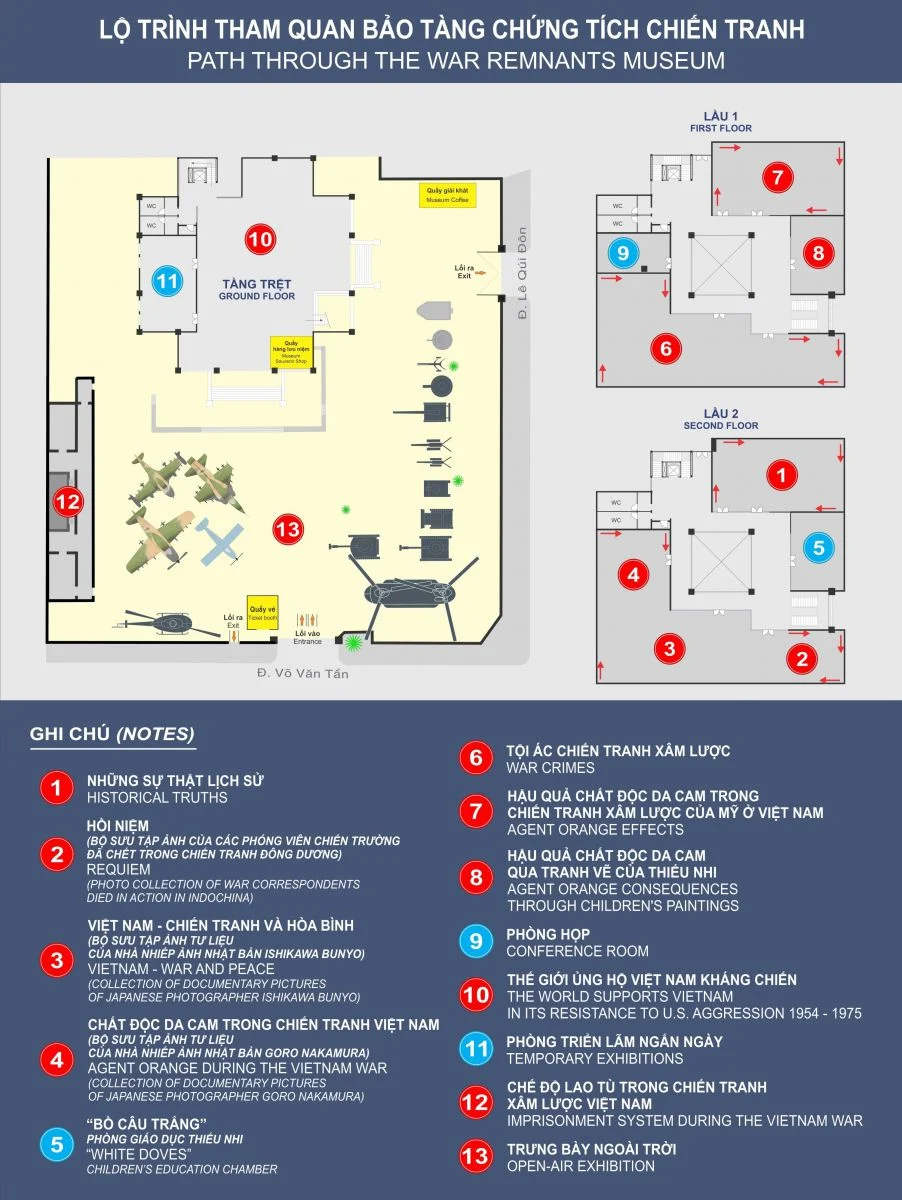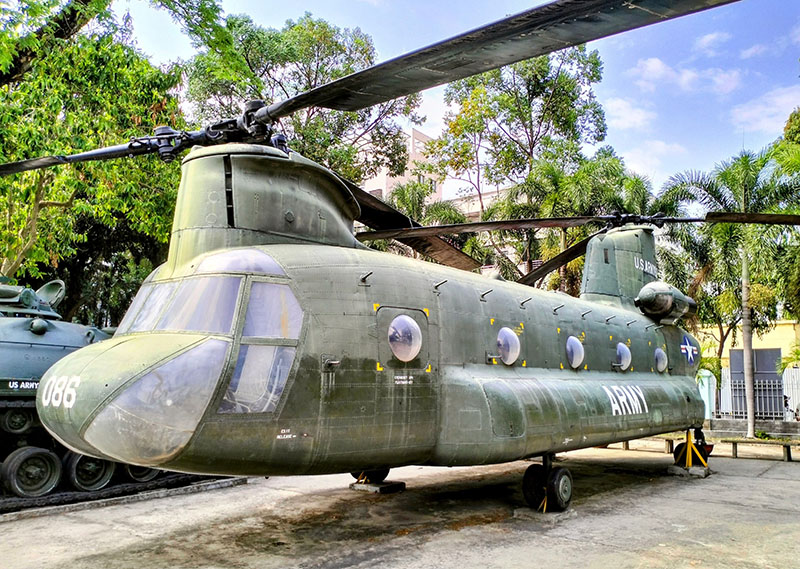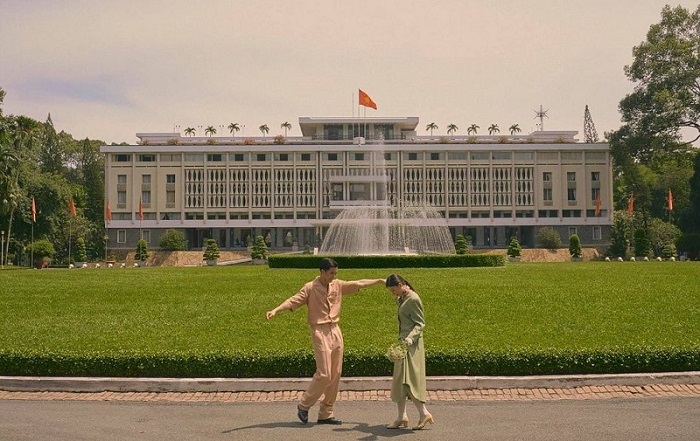The War Remnants Museum (Ho Chi Minh City) is a familiar tourist destination for both Vietnamese and international visitors. The museum is a place that preserves tens of thousands of documents, artifacts, and photographs from past wars. If you wish to visit the War Remnants Museum in Ho Chi Minh City, please follow the article below.
Table of Contents
Introduction to the War Remnants Museum
The War Remnants Museum is located on Vo Van Tan Street, District 3, Saigon. Previously, the museum was once a temple called Khai Tuong, built during the Nguyen Dynasty. After undergoing several renovations, the temple was dismantled by the French colonialists to make way for a hospital, a law office, and later a villa before becoming the museum it is today.

The museum was constructed on September 4, 1975, featuring a design that includes a total of 8 exhibition sections, along with thematic exhibitions for each year. When visiting the War Remnants Museum, tourists will witness vivid images and artifacts depicting the struggle of the nation from 1945 to 1975. Through this, you will perceive the sacrifices and losses of the main victims, including the elderly, children, and women. Alongside the resilient struggle and the enduring desire for national sovereignty by our people.
How to get to the museum
The museum is located in the city center for convenient access. Therefore, visitors can easily reach the museum by various means:
- Bus: You can take bus number 14 (departing from the Eastern Bus Station), bus number 06 (from Cho Lon Bus Station), or bus number 28 (from Ben Thanh Market) to the War Remnants Museum.
- Private car with driver: If you prefer a quick and convenient door-to-door service without waiting, the private car rental service with a driver in Ho Chi Minh City from DanangPrivateCar.com’s can assist you. With a professional and prompt driver team, they will ensure your journey is safe and comfortable.
- Taxi: Ho Chi Minh City has several taxi companies for quick transportation to the museum. Some taxi companies in the city include:
- VinaSun Taxi: 028.38.27.27.27
- VinaTaxi: 028.38.111.111
- Taxi Vina: 028.38.111.111
- Mai Linh Taxi: 028.38.38.38.38
- Taxi Airport: 028.38.42.42.42
- Taxi Chợ Lớn: 028.38.36.36.36
- Taxi Bến Thành: 028.38.422.422
- 028.38.44.6666
- 028.38.260.260
- Ride-hailing motorbike: Another option for transportation to the museum is ride-hailing motorbikes, providing a more interesting experience of the streets and alleys of Ho Chi Minh City.
- Motorbike rental: Renting a motorbike in Ho Chi Minh City allows you to independently travel to the museum by taking routes such as Cong Hoa Street or Truong Chinh Street, then turning onto Cach Mang Thang Tam Street and finally onto Vo Van Tan Street to reach the museum entrance.
Ticket prices and opening hours of the War Remnants Museum
The entrance fees for the War Remnants Museum are as follows:
- Entrance fee to the War Remnants Museum: 40,000 VND/person/visit
Note: For specific groups such as armed forces, veterans, students, pupils, and elderly officials, there will be a discount ranging from 50% to 100% on the ticket prices. Admission is free for war invalids, families of martyrs, individuals with contributions to the country, children under 6 years old, and children in remote areas.
The museum is open every day of the week, including holidays and Tet (Vietnamese New Year), from 7:30 AM to 6:00 PM.
History of the Formation of the War Remnants Museum
After the reunification of the two regions, on September 4, 1975, the War Crimes Exhibition House was opened to preserve evidence of the war, from the resistance against the French to the resistance against the United States. Later, it was renamed the Exhibition House of Crimes of War of Aggression on November 10, 1990. Finally, on July 4, 1995, it officially became the War Remnants Museum.

Currently, the museum holds more than 20,000 documents, artifacts, and photographs, with over 1,500 of them incorporated into eight regularly exhibited topics. In its nearly 50 years of operation, the War Remnants Museum has welcomed more than 15 million visitors, both domestic and international. Over the years, the museum has been honored by the state with the Labor Medal, Third Class, in 1995, and the Labor Medal, Second Class, in 2001.
In 2002, the museum underwent comprehensive modernization to better serve visitors. On April 30, 2010, the renovation and repair process was completed. The museum added new exhibition areas, expanding its collection of artifacts, documents, and photographs depicting the periods of French and Japanese invasions, as well as the post-war nation-building era.
Exploring the War Remnants Museum
The War Remnants Museum covers a large area, consisting of a modern 3-story building with a floor area of 4,522 square meters, supporting facilities, and an outdoor exhibition space of 3,026 square meters. Let’s explore in more detail with DanangPrivateCar.Com.

Ground Floor Museum Tour
The ground floor of the War Remnants Museum exhibits artifacts and specialized photographs under the theme “The world supports Vietnam’s resistance against the United States,” reflecting the history from 1954 to 1975. This section includes 100 photos and 145 types of documents and artifacts, depicting rallies, protests, conferences, and seminars worldwide in opposition to the US invasion and in support of the Vietnamese people defending national sovereignty.

Outside the ground floor museum, there is a display area for large-sized artifacts preserved from the intense war. Visitors here will explore the topic: “Prison system during the Vietnam War invasion.” The museum has constructed a model simulating the prison built by the United States and the Saigon government to detain revolutionary soldiers.
Witnessing these authentic images, many visitors feel emotionally moved. Confronted with cruel torture methods, we come to understand what hell on earth truly means.
First Floor Museum Tour
On the first floor of the War Remnants Museum, two topics are exhibited: “Crimes of the war of aggression” and “Consequences of Agent Orange.” The “Crimes of the war of aggression” section comprises 22 documents, 243 artifacts, and 125 photos highlighting the atrocities during the resistance against the US and the painful consequences endured by our people.

The “Consequences of Agent Orange” topic focuses on illustrating the devastation caused by Agent Orange. Through this, we gain a clearer understanding of the severe consequences this herbicide has inflicted on our people and our land.
Additionally, the first-floor area provides a detailed view of the My Lai massacre in Son My, Quang Ngai. The most famous image here is the photograph “Napalm Girl” by journalist Huynh Cong Ut (Nick Ut).
Second Floor Museum Tour
The second floor is the area dedicated to the topic “Historical truths” with 66 photos, 20 documents, and 153 artifacts. This section reminds us of the invasive crimes committed by French colonialists and the American empire. Alongside this is the topic “Remembrance,” featuring a collection of photos taken by journalists who lost their lives covering the Indochina battlefield.

The second floor of the War Remnants Museum also showcases two topics: “Vietnam’s war and peace” and “Agent Orange in the Vietnam War.” The poignant photojournalism by Japanese photographers Ishikawa Bunyo and Goro Nakamura provides a profound insight into the lives of our people during the war and the tremendous sacrifices made for peace
Prominent Activities of the War Remnants Museum
In addition to the permanent exhibits, the War Remnants Museum regularly organizes exhibitions, seminar programs, and educational discussions. Some notable exhibitions include:
- Exhibition Program: Dien Bien Phu from the Sky – Reflecting on 50 Years
- Exhibition Program: Rediscovering Memories
- Exhibition Program: Reviving the Dead Lands
- Exhibition Program: Paris Agreement on Vietnam – Gateway to Peace
- Mobile Exhibition Program: Vietnam – War and Peace
- Mobile Exhibition Program: Vietnamese Women’s Ao Dai through the Flames of War
- Mobile Exhibition Program: Vietnam’s Seas and Islands
Interesting Tourist Destinations Near the Museum
As the most vibrant cultural and entertainment center in Vietnam, Ho Chi Minh City offers numerous attractive destinations to meet diverse needs of visitors beyond the War Remnants Museum. Don’t forget to explore other fascinating places such as:
Southern Women’s Museum
- Address: 202 Vo Thi Sau Street, Ward 7, District 3, Ho Chi Minh City, approximately 700 meters from the War Remnants Museum.

The Southern Women’s Museum is a place that preserves and displays thousands of documents and artifacts honoring the beauty and important role of Vietnamese women throughout history. It is an attractive destination for learning interesting information and exploring an extensive collection of traditional costumes worn by Vietnamese women.
Independence Palace (Dinh Doc Lap)
- Address: 135 Nam Ky Khoi Nghia Street, Ben Thanh Ward, District 1, Ho Chi Minh City, approximately 600 meters from the museum.

Independence Palace is a special national monument that witnessed the events of the Liberation of the South on April 30, 1975. Here, you can explore unique architecture and admire many preserved historical artifacts.
Saigon Zoo and Botanical Gardens
- Address: 02 Nguyen Binh Khiem Street, Ben Nghe Ward, District 1, Ho Chi Minh City, approximately 2.5 kilometers from the museum.
Saigon Zoo and Botanical Gardens is a famous zoo in Ho Chi Minh City and a favorite destination for many young people and families. The zoo cares for over 1,000 animal specimens and features more than 2,000 unique plant species, providing visitors with memorable experiences.
Tips for Visiting the War Remnants Museum
Here are some important notes to keep in mind when visiting the War Remnants Museum in Ho Chi Minh City:
- If you plan to visit on weekends or during holidays, consider going early to avoid spending time in ticket queues.
- Due to the museum’s extensive space, visiting in the morning allows you to explore more.
- Do not touch the artifacts in the museum on your own.
- Do not take photos in areas marked with signs within the museum premises.
- You can hire a guide to receive detailed information about the museum.
- For group tours or school trips, it’s advisable to contact the museum in advance to purchase tickets.
- Combine your visit with exploring nearby famous places such as Turtle Lake and Le Thi Rieng Park.
- Nearby recommended dining places include Thuc Coffee Shop, Dong Restaurant, etc.
This article contains information that the travel guide DanangPrivateCar.com’s wants to provide to help you prepare for your journey to explore the War Remnants Museum. We hope you have a trip filled with memorable experiences and gain a deeper understanding of the heroic history of the Vietnamese nation.

Comments